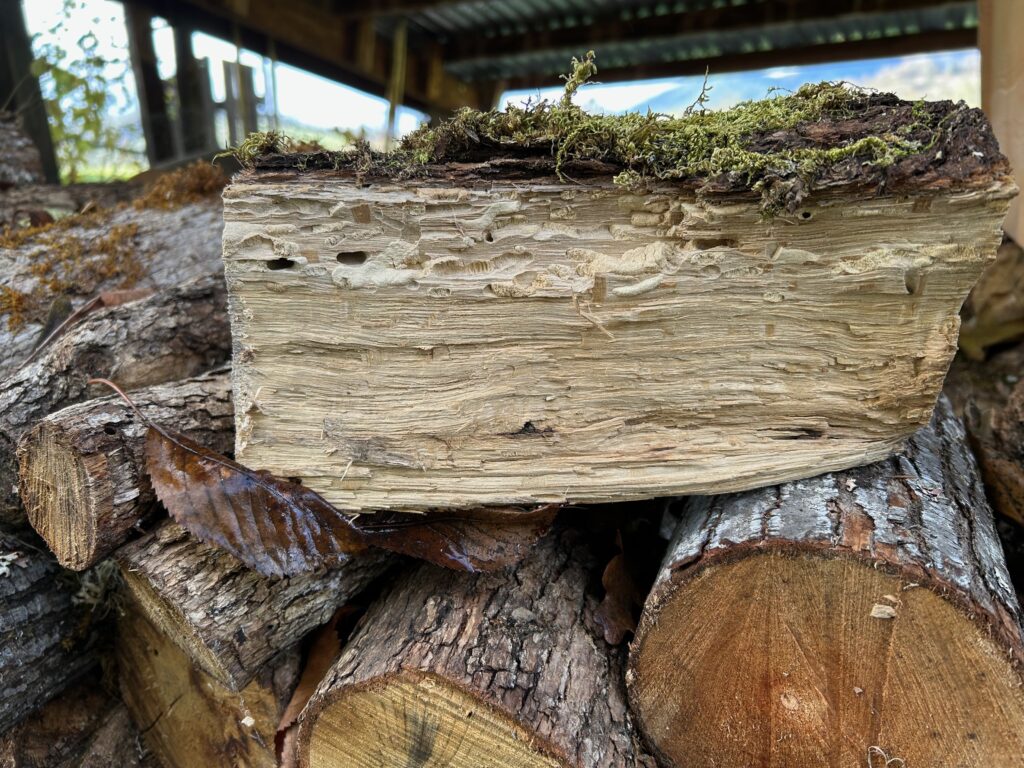



This article was published in the News-Review on November 22, 2024
By: Bonnie Courter
Question: Now that the days and nights are getting colder, I’ve noticed a lot more spiders and bugs invading our living room. Where are they coming from? Could it be from the firewood stacked beside our wood stove?
Answer: Your inside firewood box very well could be the prime source of these uninvited pests. It’s common for insects, spiders and other hitchhikers to be found living or hiding in stacks of firewood that have been stored over the years. Some feed on dead wood, their larvae tunneling through the phloem of the logs. Spiders, pillbugs, centipedes, millipedes, or even wasps and hornets like to overwinter under the loose bark. When logs are brought inside the home where it’s warm, these critters will wake up or hatch, thinking it’s spring, and crawl out. Since they don’t present any harm to you or your home, they need only to be picked up and shooed out the door.
Adult longhorned beetles and metallic woodboring beetles, while a nuisance if they emerge from your firewood, will not harm the wood in your home – it’s their larvae that could pose a problem. Female beetles, which are attracted to dying or freshly cut trees, lay their eggs there, then their larvae hatch and burrow into the tree, spending one to several years as borers, tunneling through the wood. Once mature, they will leave telltale “exit holes” in the wood.
Bark beetles are also commonly found in firewood that has been cut from dead trees since they attack dead or dying trees. They spend almost their entire life cycle under the bark, feeding on the phloem tissue. Their boring dust is usually brown-colored and very fine. On pine trees, pitch tubes may be an indicator of their presence. Bark beetles are small (less than 1/8”), brown or black, with cylindrical bodies. Since adult beetles seem to attack wood in groups, a log cut from a tree infested with bark beetles can contain hundreds of beetles.
Two insects that may cause problems if your firewood is stacked on the ground and against your house are termites and carpenter ants. Termite colonies are located in the soil, so if firewood is stacked directly on the ground, the termite workers can tunnel into the firewood. The main termite nest containing the queen is underground and often at a distance from where you might see the workers. If the woodpile is stacked on the ground and against the sides of the house, it can serve as an avenue for termites to infest the structure. Mud tunnels in the ground near the firewood may indicate the presence of termites.
Carpenter ants, unlike termites, do not eat wood, but merely hollow out galleries or nests in the wood. Such galleries are smooth, following the grain of the wood, and are very clean with no mud or sawdust. Carpenter ants are larger than black ants, about 3/8” in length. Should they be brought inside your warm house in the firewood, they may move out of the wood. However they are just an annoyance and will unlikely establish a nest in your house.
So here’s some ways to lessen the chance of firewood pests in your home:
- Stack firewood off the ground and away from your house. This aids in drying, plus it makes it more difficult for insects to crawl into the woodpile.
- Avoid letting firewood sit inside for too long. Leave firewood outside until a day or two before you plan to burn it. Since insects remain cold and inactive in firewood stored outdoors, it generally requires a couple of days before they warm up and become active.
- Inspect your firewood before bringing it indoors. Knock logs together to dislodge any obvious cocoons or insects.
- Since wood borer larvae can hitch a ride in pieces of firewood, emerging later as adults, don’t move firewood across state lines or even long distances within your state. That can lead to the spread of damaging invasive insects such as the emerald ask borer and Asian longhorned beetle.
- Reduce the chances of beetles invading your firewood by harvesting and processing green wood such as standing madrone during the fall and winter when the beetles are not in flight.
- Do NOT apply pesticides to firewood which don’t affect insects bored into the wood. Also harmful fumes could be produced when burned.
If you do get some uninvited “pest guests” this winter, don’t be alarmed – just vacuum or sweep them up and show them the door!
Do you have a gardening or insect question? Contact the Douglas County Master Gardeners at douglasmg@oregonstate.edu or 541-672-4461 or visit 1134 SE Douglas Ave., Roseburg. Douglas County Master Gardeners are trained volunteers who help the OSU Extension Service serve the people of Douglas County.

